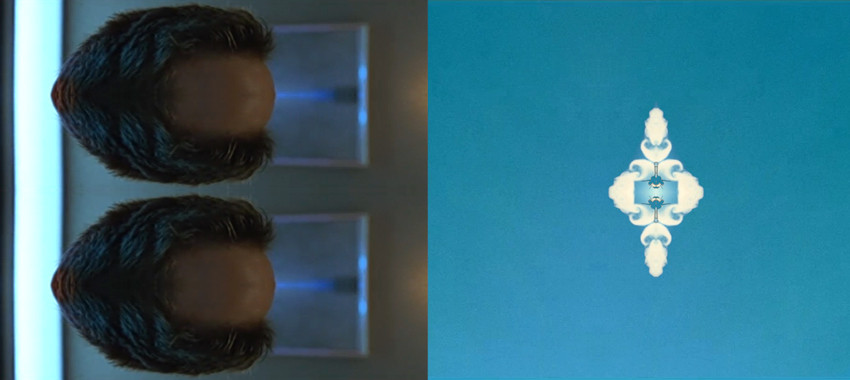 Baden Pailthorpe, H(Air) Force One, 2012
Baden Pailthorpe, H(Air) Force One, 2012Courtesy of the artist and Sullivan+Strumpf, Sydney
H(Air) Force One and Very Few Good Men (both 2012) are experimental video works by Baden Pailthorpe that establish key themes of power, technology and military aesthetics early in his practice. Remixing scenes from Hollywood films, Top Gun (Dir. Tony Scott, 1986) and A Few Good Men (Dir. Rob Reiner, 1992) respectively, Pailthorpe’s videos unpack the mythologies of cinema representations via the propagandist intersection of militarism and popular culture. Through his digital interventions into these mainstream Western cultural artefacts, Pailthorpe extracts their hidden aesthetic and counternarrative potential.
In both works, Pailthorpe uses a technical process that folds the imagery onto itself, akin to an animated Rorschach sequence. Abstract and kaleidoscopic, the appropriated imagery and diegetic sound becomes hypnotic, uncanny and absurd through its digital manipulation. This ‘folding’ process conceptually mirrors the regulatory aesthetics on which the military operates. Very Few Good Men reworks A Few Good Men’s opening scene, which depicts an armed drill. Played by a real-life Marine Corps, the Fish Drill Team from Texas A&M University, the tightly choreographed sequence accentuates the importance of the collective over the individual in a military setting. Conversely, H(Air) Force One appropriates clips from Top Gun that focus on the showy individualism of its characters played by Tom Cruise and Val Kilmer – not by their now obscured faces, but through their 1980s hairstyles. The folding technique transforms these otherwise recognisable actors into fleshy fetish objects that inhabit a strange tessellating world built from Top Gun’s heterosexual (and homosocially motivated) energy.
Though both works are cut from the same uniformed cloth, Very Few Good Men examines precision, discipline, order and synchronicity while H(Air) Force One considers the aesthetics of bodies within institutional regimes. In this context, individuality is quashed as bodies form into a group that performs set roles to violent ends (despite the ironic metanarrative that in performing such roles celebrity actors draw attention to a heightened fantasy of self via fame). For Pailthorpe, the infinitely repeatable patterning of the imagery plays on the formations of individuals into groups who interact together. Very Few Good Men was first presented as a looped two-channel video at Martin Browne Contemporary in 2012. Later, in 2015, Pailthorpe displayed the work as a 10-channel video that was vertically stacked in the central tower of Casula Powerhouse Arts Centre. By presenting the work in a modular way, Pailthorpe echoes the scalable manoeuvring of military action.
Repetition thus becomes an aesthetic expression of how bodies are coordinated together across time and space. This can be likened to how major studio film productions function as a similarly militaristic, logistical and algorithmic operation, even though a sole artist like Pailthorpe can undo this logic by using available digital tools to remix the film as a found object and thereby expose and decentre its ideological footing.
Courtesy of the artist and Sullivan+Strumpf, Sydney
Catalogue essay for The Art of Giving at Macquarie University Art Gallery, Sydney, December 2022 – March 2023.
Published by Macquarie University in 2022.